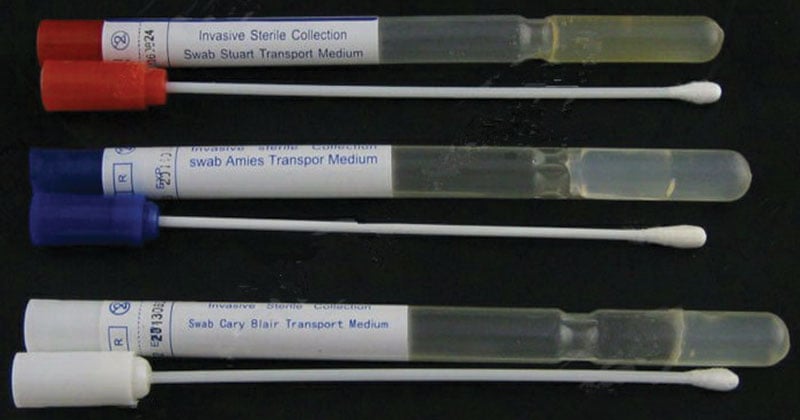Amies Transport Medium is an improved transport medium, containing charcoal to prolong the viability of pathogenic organisms. It is a semisolid media recommended for use in qualitative procedures for the transport of clinical swab specimens to the laboratory. It is the modified Stuart’s Transport Medium produced by replacing glycerophosphate with an inorganic phosphate buffer and adding charcoal to the medium. This modified medium gave a higher percentage of positive results than the transport medium of Stuart.

Interesting Science Videos
Composition of Amies Transport Medium
| Ingredients | Gms/liter |
| Sodium chloride | 3.000 |
| Potassium chloride | 0.200 |
| Calcium chloride | 0.100 |
| Magnesium chloride | 0.100 |
| Monopotassium phosphate | 0.200 |
| Disodium phosphate | 1.150 |
| Sodium thioglycollate | 1.000 |
| Charcoal | 10.000 |
| Agar | 4.000 |
Final pH (at 25°C) 7.2±0.2
Principle of Amies Transport Medium
Amies Transport Medium provides a reduced environment due to the presence of sodium thioglycollate and the small amount of agar. Charcoal helps to neutralize materials that are toxic to sensitive pathogens like Neisseria gonorrhoeae. Calcium magnesium, potassium, and sodium salts help the survival of gonococcal cells and also control the permeability of bacterial cells. Phosphates buffer the medium.
Preparation of Amies Transport Medium
- Suspend 20g in 1 litre of distilled water.
- Bring to the boil to dissolve the agar completely.
- Distribute into small, screwcap bottles, stirring meanwhile to keep the charcoal evenly suspended.
- Screw down the caps firmly on the completely filled bottles.
- Sterilize by autoclaving at 121°C for 15 minutes. Invert the bottles whilst cooling to distribute the charcoal uniformly.
- Store in a cool place until use.
- Use sterile, cotton-tipped swabs on wooden sticks to collect the specimen.
- Push the swab down one-third of the medium depth and cut the stick so that when the cap is screwed down, the swab is forced to the bottom of the medium.
- Make sure the cap is screwed firmly on the bottle and keep cool during the transport period.
Result Interpretation on Amies Transport Medium
| Organisms | Growth |
| Escherichia coli | Good recovery on subculture |
| Klebsiella pneumoniae | Good recovery on subculture |
| Neisseria meningitidis | Good recovery on subculture |
| Pseudomonas aeruginosa | Good recovery on subculture |
| Salmonella Typhi | Good recovery on subculture |
| Shigella flexneri | Good recovery on subculture |
| Staphylococcus aureus subsp. aureus | Good recovery on subculture |
| Vibrio cholerae | Good recovery on subculture |
| Bacteroides fragilis | Good recovery on subculture |
| Haemophilus influenzae | Good recovery on subculture |
| Neisseria gonorrhoeae | Good recovery on subculture |
| Streptococcus pyogenes | Good recovery on subculture |
Uses of Amies Transport Medium
- It is used for collecting, transporting and preserving microbiological specimens.
- It is formulated to maintain the viability of microorganisms without a significant increase in growth, being nonnutritive, phosphate buffered and semi-solid.
- It is a transport medium used to preserve the viability of anaerobes such as Neisseria gonorrhea and other pathogens from swabs.
- It is used for preservation of microbiological specimen.
- It is recommended for the throat, vaginal, and wound samples.
Limitations of Amies Transport Medium
- The old medium should be freshly steamed and the charcoal resuspended before use.
- Some growth of contaminants may also occur during the long period of transport.
- After transportation, the specimen should be inoculated in the proper medium as soon as possible. For optimum results, the time lapse between sample collection and inoculum onto culture medium should be reduced to the minimum.
- It may not be suitable for the transport of fastidious organisms.
- Gonococci survive well in Amies Transport Medium for at least 6 to 12 hours provided they are not exposed to temperature extremes. By 24 hours, the numbers of gonococci decrease to an extent that may prevent their recovery if small numbers were present initially in the specimen.
References
- http://himedialabs.com/TD/M651.pdf
- http://www.oxoid.com/UK/blue/prod_detail/prod_detail.asp?pr=CM0425&c=UK&lang=EN
- https://assets.thermofisher.com/TFS-Assets/LSG/manuals/IFU60060.pdf
- https://www.condalab.com/pdf/1535.pdf
- http://www.srlchem.com/products/product_details/productId/3537/Amies-Transport-Medium-with-Charcoal
- http://www.himedialabs.com/

Thanks for ur lectures,but pls,in detecting coliform in diary industry which media is most effective :Violet bile red agar (vbra) or mac agar or broth. Plz I need urgent reply